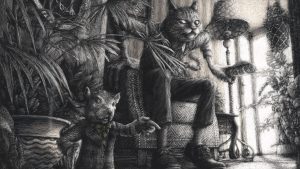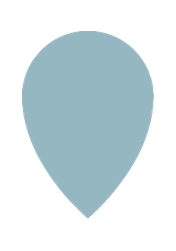Grattage, a simple and intuitive painting technique, is particularly suitable to practise two fundamental concepts of tonal/painting design: volume (light/shadow) and sign (textures). A technique used since the dawn of painting is the procedure whereby using drills, palette knives, blades, etc., the surface layer of paint/ink is scraped away to make the underlying layers (other pigment, support, etc.) visible. During the course, through a series of targeted exercises, we will experience the potential and formal applications of this technique both for tonal rendering, i.e. for the creation of volumes, and for pictorial texture.
Programme
The course will be developed in 5 phases.
1. Creation of the subject: participants will be asked to create the image of an object or character. There will be no limitation regarding the representation technique to be used (drawing, painting, collage, digital processing, etc.) but there will be a fundamental one regarding the physical nature of the object or character (henceforth “figure”) represented: it must necessarily have, even if totally invented, a three-dimensional volumetric extension.
2. Modelling the figure in plasticine: participants will be asked to create a small sculpture modelled in plasticine (synthetic clay, polymer clay, etc.) of the previously created figure. Naturally, the aim of the exercise will be to become aware of the volumetric extension of the figure in all its parts: to this end, it will be fine to model a very synthetic sketch of the forms, nothing excessively elaborated.
3. Photographing the figure modelled in plasticine and printing it on an A3 sheet: the figurines thus created will be photographed in an environment with a single light source, limiting refractions and reflections from surrounding objects as much as possible. The resulting photos will be suitably optimised with any digital image processing software and printed in A3 format, black and white; this can be done using a simple A4 office printer by combining two or more sheets.
4. Recalculating the photocopy on a translucent sheet and graphic rendering of the volumes (lights/shadows): Participants will be asked to recalculate on a translucent sheet, by simple overlapping in transparency i.e. by positioning the translucent sheet on the photocopy and fixing it with paper tape, the contours and main outlines of the figures represented photographically in the A3 prints, using coloured pencils. We will then render the lights and shadows of the traced figure on the same translucent sheet using tonal textures. This is how it will be done: using an ink pen or grease pencil, you will lay down uniform backgrounds in order to blacken all the dark and intermediate tonal areas of the drawn figure with the exception of the maximum light areas. Once this has been done, all the intermediate light/shadow areas are artfully lightened by scratching away the black pigments, previously spread on the translucent, using razor blades, gouges, needles or other medium-sharp metal-tipped tools.
5. Tonal rendering of the figure on the scratchboard sheet: the procedure on the scratchboard will be very similar to the experience on the translucent sheet. The contours and main outlines of the figure will be transposed from the photocopy to the scratchboard by means of a simple contact print using the same mechanism as for carbon paper. Then the volumes of the figure will be rendered on the scratchboard, naturally using the sketches as a reference, using tonal textures. Using razor blades, gouges, needles or other metal-tipped tools, one will artfully lighten, by means of similar marks at varying distances, to create more or less light textures, all areas of light, scratching away the black pigments of the top layer of the scratchboard. As before, for participants unaccustomed to tonal drawing, we will proceed by trial and error, alternating the operation of scratching to lighten with that of re-inking with black marks to darken. Once the operation is completed, the tonal passages will be harmonised and softened: if one has worked using a mark and a scratch of similar width and length and adjusting the distance between the marks according to the tone to be rendered, the effect will be remarkable and aesthetically pleasing even where the tonal rendering is not perfect. Also in this phase, as in the previous one, there will be a group critical analysis of all the works to familiarise with the potential of the technique.
Illustration by Claudio Losghi, Piccola favola (F. Kafka), detail from “Odradek! Illustrations for Short Stories”, private commission, 2019, ink and scalpel on scratchboard





